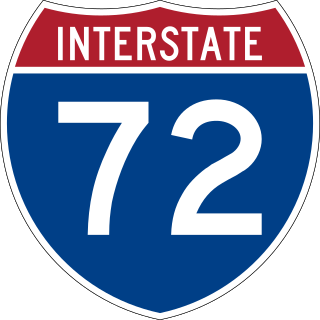
Interstate 72 (I-72) is an Interstate Highway in the midwestern United States. Its western terminus is in Hannibal, Missouri, at an intersection with U.S. Route 61 (US 61); its eastern terminus is at Country Fair Drive in Champaign, Illinois. The route runs through the major cities of Decatur, Illinois, and Springfield, Illinois. In 2006, the Illinois General Assembly dedicated all of I-72 as Purple Heart Memorial Highway. The stretch between Springfield and Decatur is also called Penny Severns Memorial Expressway, and the section between mile 35 and the Mississippi River is known as the Free Frank McWorter Historic Highway.

Interstate 355 (I-355), also known as the Veterans Memorial Tollway, is an Interstate Highway and tollway in the western and southwest suburbs of Chicago in the U.S. state of Illinois. Like most other toll roads in the northeastern portion of the state, I-355 is maintained by the Illinois State Toll Highway Authority (ISTHA). I-355 runs from I-80 in New Lenox north to I-290 in Itasca, a distance of 32.5 miles (52.3 km). With the exception of a four-mile (6.4 km) expansion in 2009, from U.S. Route 34 to 75th Street, the highway is six lanes wide for its entire length.
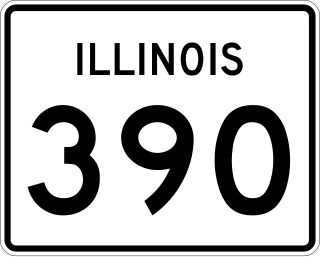
Illinois Route 390 (IL 390), previously known as the Elgin–O'Hare Expressway, now known as the Elgin–O'Hare Tollway, is a 9.8-mile-long (15.8 km) electronic toll highway in northeastern Illinois. IL 390 currently connects U.S. Route 20 in Hanover Park to the interchange with Illinois Route 83 and Thorndale Avenue in Wood Dale. The only other towns it borders are Schaumburg and Roselle. Construction is underway to extend the road from IL 83 to the western edge of O'Hare International Airport.

Interstate 88 (I-88) is an Interstate Highway in the US state of Illinois that runs from an interchange with I-80 near Silvis and Moline to an interchange with I-290 and I-294 in Hillside, near Chicago. I-88 is 140.60 miles (226.27 km) long. This route is not contiguous with I-88 in New York. Since 2010, most of I-88 has been part of the Chicago–Kansas City Expressway. The highway also runs through the cities of Aurora, Naperville, DeKalb, and Dixon. East of Rock Falls, the route is a part of the Illinois Tollway system.
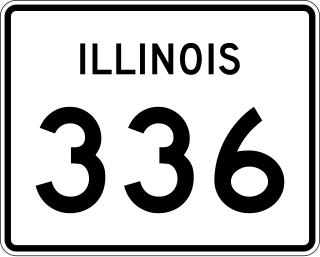
Illinois Route 336 is a four-lane freeway/expressway combination that serves western Illinois. It is also used by the Illinois Department of Transportation (IDOT) as a part of Federal-Aid Primary Highway 315 (FAP315) to refer to a future project connecting the cities of Quincy and Peoria via underserved Macomb.

The Black Hawk was an Amtrak passenger train service that operated from 1974 to 1981 between Chicago, Illinois, and Dubuque, Iowa, via Rockford, Illinois. The original Black Hawk operated over the Illinois Central route, now the Canadian National's Chicago Central/Iowa Zone. From 2010 to 2014, plans called for the restored route to follow the same corridor; however, the state government could not come to an agreement with the railroad. Instead, the route would follow Metra's Milwaukee District / West Line from Union Station to Big Timber Road, then the Union Pacific Railroad to Rockford. Restored service to Rockford was planned to begin in 2015, but was put on hold by Illinois Governor Bruce Rauner. An extension to Dubuque was to open at a later date. The Rockford service was later funded in 2019 with the support of Governor J.B. Pritzker. In July 2023, Pritzker announced that two round trips a day between Chicago and Rockford would begin by 2027, with the service operated by Metra as Rockford Intercity Passenger Rail rather than by Amtrak.

The William H. Natcher Green River Parkway was the designation for a 72.3-mile (116.4 km) freeway that ran from Bowling Green to Owensboro in the US commonwealth of Kentucky. The Natcher Parkway was one of nine highways that were a part of Kentucky's parkway system. The portion north of Interstate 65 (I-65) was signed as I-165, and the portion south of I-65 as Kentucky Route 9007 on March 6, 2019.

Forgottonia, also spelled Forgotonia, is the name given to a 16-county region in Western Illinois in the late 1960s and early 1970s. This geographic region forms the distinctive western bulge of Illinois that is roughly equivalent to "The Tract", the Illinois portion of the Military Tract of 1812, along and west of the Fourth Principal Meridian. Since this wedge-shaped region lies between the Illinois and Mississippi rivers, it has historically been isolated from the eastern portion of Central Illinois.
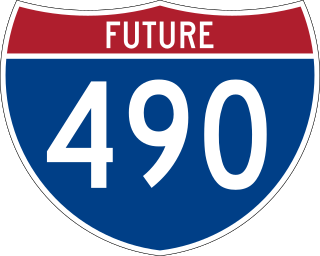
Interstate 490 (I-490), also known as O'Hare West Bypass and Western O'Hare Beltway, is an electronic toll highway and a beltway that is currently under construction near Chicago, Illinois; it will run along the west side of O'Hare International Airport. The tollway will connect I-294 to a western access point to the airport. From there, it will continue northward to an extension of Illinois Route 390 and I-90. The O'Hare Western Bypass is part of the Elgin–O'Hare Western Access (EOWA) project. Building the highway will affect the villages of Elk Grove Village, Wood Dale, Itasca, and Bensenville. The route will run through the American Airlines Flight 191 crash site, the deadliest aviation accident in US history.
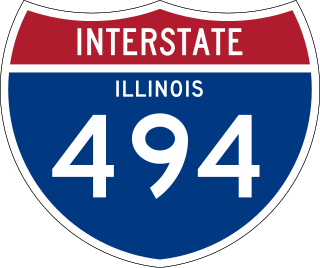
The Crosstown Expressway, suggested as Interstate 494 (I-494), was a proposed highway route in Chicago, Illinois. It was originally planned through the 1960s and 1970s.
The Illinois Department of Transportation (IDOT) is a state agency in charge of state-maintained public roadways of the U.S. state of Illinois. In addition, IDOT provides funding for rail, public transit and airport projects and administers fuel tax and federal funding to local jurisdictions in the state. The Secretary of Transportation reports to the Governor of Illinois. IDOT is headquartered in unincorporated Sangamon County, located near the state capital, Springfield. In addition, the IDOT Division of Highways has offices in nine locations throughout the state.

Interstate 66 (I-66) is a canceled Interstate Highway designated in the Intermodal Surface Transportation Efficiency Act (ISTEA) of 1991 as the East–West TransAmerica Corridor and High Priority Corridor 3.

Interstate 80 (I-80) is a part of the Interstate Highway System that runs from San Francisco, California, to Teaneck, New Jersey. I-80 enters Illinois from Iowa in the west, southwest of Rapids City, and runs generally eastward through East Moline, LaSalle, and Joliet, before entering Indiana in Lansing. The Interstate runs for approximately 163.52 miles (263.16 km) through the state.
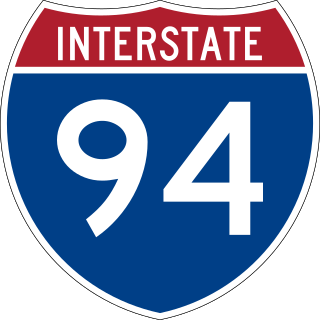
Interstate 94 (I-94) generally runs north–south through the northeastern portion of the US state of Illinois, in Lake and Cook counties. It is signed east–west in Illinois in accordance with its general alignment across the country, with west signage aligned with northbound travel and vice versa. I-94 in Illinois is 61.53 miles (99.02 km) long.
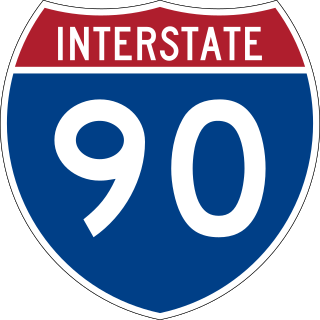
Interstate 90 (I-90) in the US state of Illinois runs roughly northwest-to-southeast through the northern part of the state. From the Wisconsin state line at South Beloit, it heads south to Rockford before heading east-southeast to the Indiana state line at Chicago. I-90 traverses 124 miles (200 km) through a variety of settings, from farmland west of the Fox River Valley through the medium-density suburbs west of O'Hare International Airport, through Downtown Chicago, and through the heart of the industrial southeast side of Chicago before entering Indiana.
The Chicago Metropolitan Agency for Planning (CMAP) is a metropolitan planning organization (MPO) responsible for comprehensive regional transportation planning in Cook, DuPage, Kane, Kendall, Lake, McHenry and Will counties in northeastern Illinois. The agency developed and now guides implementation of ON TO 2050, a new long-range plan to help the seven counties and 284 communities of northeastern Illinois implement strategies that address transportation, housing, economic development, open space, the environment, and other quality-of-life issues.
Highway revolts have occurred in cities and regions across the United States. In many cities, there remain unused highways, abruptly terminating freeway alignments, and short stretches of freeway in the middle of nowhere, all of which are evidence of larger projects which were never completed. In some instances, freeway revolts have led to the eventual removal or relocation of freeways that had been built.
The Quad Cities is a planned Amtrak Illinois Service intercity passenger train that will operate between Chicago and Moline in the US state of Illinois. The train will duplicate the route and stations of the Carl Sandburg and Illinois Zephyr between Chicago and Wyanet using track owned by BNSF. On the Wyanet–Moline segment, which will include a station at Geneseo, the train will use track owned by Iowa Interstate Railroad.
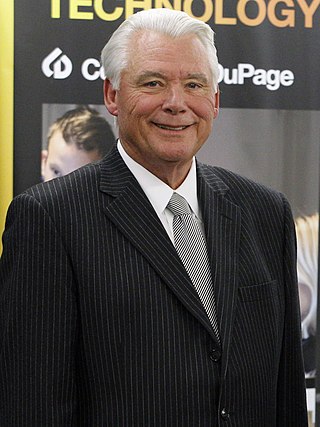
Gregory W. Baise is an American politician. He previously served as the longtime president and CEO of the Illinois Manufacturers' Association. Before that, Baise served in many political and governmental roles, including as Illinois Secretary of Transportation, in which role he was director of the Illinois Department of Transportation.

















